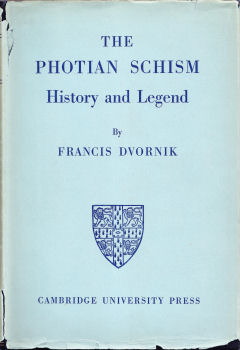 |
The Photian schism. History and Legend
By Francis Dvornik
Cambridge University Press Cambridge 1948
Scans in .pdf format (17.8 Mb) |
 |
The Photian schism. History and Legend
By Francis Dvornik
Cambridge University Press Cambridge 1948
Scans in .pdf format (17.8 Mb) |
To the memory of my teacher Charles Diehl
I. Political Parties, Religious Problems and Opening Conflict
Introduction: Photius’ case—Political and religious parties in Byzantium— Extremists and Moderates in Irene’s and Nicephorus’ reigns—Moderate policy of Methodius and the Studite Schism—Was Ignatius appointed or elected?—When and why Gregory Asbestas, leader of the Moderates, was condemned by Ignatius—Gregory’s appeal to Rome and the Holy See’s attitude—Extremist and Moderate intrigues.
II. Ignatius’ Resignation and Photius’ Canonical Election
Nicetas’ testimony—Ignatius’ abdication confirmed by the Extremists’ reports—Photius’ canonical election—Asbestas and Photius’ consecration— Extremists’ revolt and its motives—Photius’ reaction—Repercussions of these conflicts among the episcopacy and the monastic world.
III. The Synod of 861
Photius’ and Michael’s letters to Nicholas—Was the Pope in communion with Photius’ envoys?—Negotiations between the legates, the Emperor and the Patriarch before the synod—The Acts of the synod and accounts by Nicetas and Theognostos—Did Ignatius appeal to Rome?—Legates’ attitude during the synod.
IV. Nicholas, Photius and Boris
Radoald and Zachary return to Rome—Nicholas’ policy and letters to the Emperor and the Patriarch—Theognostos and the Roman Synod of 863— Byzantine reaction in Bulgaria and its development in Rome—Nicholas’ fatal reply—Was the breach permanent?—Reaction in Byzantium—Boris’ volte-face; his influence on the growth of the conflict—The Byzantine Synod of 867—Did Photius challenge the Roman primacy?
V. Photius’ Downfall and the Council of 869-70
Michael’s regime, Basil and the Extremists—Did Photius resign?—Basil’s embassy to Rome—Hadrian II’s reaction—The Council of 869-70—The Emperor and the legates’ uncompromising attitude—The Bulgarian incident—Was Ignatius’ recognition by the Pope conditional?
VI. Photius’ Rehabilitation and the Synod of 879-80
Ignatius’ difficulties—Basil’s change of policy and his reconciliation with the Moderates and Photius—Ignatius and Photius on friendly terms—John VIII, Basil and Photius—Papal letters analysed—Pourparlers with the legates in Byzantium—The ‘Greek edition’ of the pontifical letters—The first five sessions of the Council—Authenticity of the sixth and seventh sessions— John VIII’s alleged letter on the Filioque—The legates and the primacy.
VII. The Second Schism of Photius, A Historical Mystification
Photius’ letters to the Roman bishops—John VIII approves the Acts of the Council—Basis of the compromise concerning Bulgaria—Anti-Photian Collection and the legend of Photius’ second condemnation by John VIII—Photius, Marinus I and Hadrian III—Stephen V and Byzantium—Stephen’s letters on the Photian incident.
VIII. Photius, Leo VI and the Healing of the Extremists’ Schism
Photius acknowledged by the Moderate Ignatians—Leo VI’s change of policy and Photius’ resignation—Leo, the ‘Little Church’ and the Moderates—Was there a schism under Formosus?—The ‘Little Church’s’ liquidation— A reunion synod in 899?—Authorship of the Anti-Photian Collection and date of composition of the Vita Ignatii—The Extremists and the Moderates in the tetragamy conflict.
I. The Photian Case in Latin Literature till the Twelfth Century
Contemporary repercussions—The Anselmo Dedicata—Tenth-century writers—Unpublished canonical Collections of the tenth century—Historians of the eleventh century—The Photian case in the ‘Gregorians” canonical Collections—The Latin Acts of the Photian Council in the writings of Deusdedit and Ivo of Chartres.
II. Oecumenicity of the Eighth Council in Medieval Western Tradition
Number of councils acknowledged by the Gallic, Germanic, English and Lombard Churches until the twelfth century—Rome and the seven councils —The Popes’ profession of faith and the number of councils—Eleventh-century canonists and the Eighth Council—Was there any other edition of the Popes’ Professio fidei covering the eight councils?
III. Western Tradition from the Twelfth to the Fifteenth Century
The Eighth Council in pre-Gratian law Collections, influenced by Gregorian canonists—Collections dependent on Deusdedit and Ivo—Gratian’s Decretum and the Photian Legend—From Gratian to the fifteenth century: Canonists —Theological writers and Historians.
IV. Fifteenth Century till the Modern Period
The Eighth Council among opponents and supporters—Sixteenth-century writers—The Centuriae—Baronius’ Annals—Catholic and Protestant writers of the eighteenth century—Hergenröther and his school.
V. Photius and the Eighth Council in the Eastern Tradition till the Twelfth Century
Unpublished treatise on the Councils by the Patriarch Euthymios—Other contemporaries—Photius’ canonization—Historians of Constantine Porphyrogennetos’ school—Polemists of the eleventh and twelfth centuries— Michael of Anchialos—Twelfth-century chroniclers.
VI. From the Thirteenth Century to the Modern Period
Unionists of the thirteenth century: Beccos, Metochita—The Photian Council in writings of the thirteenth century—Calecas and the champions of the Catholic thesis—Anti-Latin polemists and theologians of the fourteenth century: the Photian Council promoted to oecumenicity—Treatment of Photius and his Council by supporters of the Council of Florence— Unpublished Greek treatises on the Councils and opponents of the Union —Greek and Russian literature from the sixteenth to the nineteenth century—Influence of Baronius and Hergenröther on the Orientals.
Appendix I. New Edition of the Liber Diurnus (eleventh century) and the Number of Councils listed as Oecumenical
Appendix II. Popes’ Profession of Faith in Cod. Bibl. Vat. Lat. 7160 and the Profession of Boniface VIII
Appendix III. Unpublished anonymous Greek Treatises on the Councils
List of Manuscripts Quoted (Greek Manuscripts, Latin Manuscripts) — List of Sources